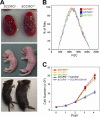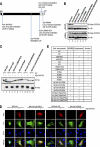SCCRO (DCUN1D1) promotes nuclear translocation and assembly of the neddylation E3 complex
- PMID: 21247897
- PMCID: PMC3060484
- DOI: 10.1074/jbc.M110.203729
SCCRO (DCUN1D1) promotes nuclear translocation and assembly of the neddylation E3 complex
Abstract
SCCRO/DCUN1D1/DCN1 (squamous cell carcinoma-related oncogene/defective in cullin neddylation 1 domain containing 1/defective in cullin neddylation) serves as an accessory E3 in neddylation by binding to cullin and Ubc12 to allow efficient transfer of Nedd8. In this work we show that SCCRO has broader, pleiotropic effects that are essential for cullin neddylation in vivo. Reduced primary nuclear localization of Cul1 accompanying decreased neddylation and proliferation in SCCRO(-/-) mouse embryonic fibroblasts led us to investigate whether compartmentalization plays a regulatory role. Decreased nuclear localization, neddylation, and defective proliferation in SCCRO(-/-) mouse embryonic fibroblasts were rescued by transgenic expression of SCCRO. Expression of reciprocal SCCRO and Cul1-binding mutants confirmed the requirement for SCCRO in nuclear translocation and neddylation of cullins in vivo. Nuclear translocation of Cul1 by tagging with a nuclear localization sequence allowed neddylation independent of SCCRO, but at a lower level. We found that in the nucleus, SCCRO enhances recruitment of Ubc12 to Cul1 to promote neddylation. These findings suggest that SCCRO has an essential role in neddylation in vivo involving nuclear localization of neddylation components and recruitment and proper positioning of Ubc12.
Figures







Similar articles
-
SCCRO3 (DCUN1D3) antagonizes the neddylation and oncogenic activity of SCCRO (DCUN1D1).J Biol Chem. 2014 Dec 12;289(50):34728-42. doi: 10.1074/jbc.M114.585505. Epub 2014 Oct 27. J Biol Chem. 2014. PMID: 25349211 Free PMC article.
-
SCCRO (DCUN1D1) is an essential component of the E3 complex for neddylation.J Biol Chem. 2008 Nov 28;283(48):33211-20. doi: 10.1074/jbc.M804440200. Epub 2008 Sep 30. J Biol Chem. 2008. PMID: 18826954 Free PMC article.
-
Squamous cell carcinoma-related oncogene (SCCRO) neddylates Cul3 protein to selectively promote midbody localization and activity of Cul3KLHL21 protein complex during abscission.J Biol Chem. 2017 Sep 15;292(37):15254-15265. doi: 10.1074/jbc.M117.778530. Epub 2017 Jun 15. J Biol Chem. 2017. PMID: 28620047 Free PMC article.
-
Protein neddylation: beyond cullin-RING ligases.Nat Rev Mol Cell Biol. 2015 Jan;16(1):30-44. doi: 10.1038/nrm3919. Nat Rev Mol Cell Biol. 2015. PMID: 25531226 Free PMC article. Review.
-
Diverse and pivotal roles of neddylation in metabolism and immunity.FEBS J. 2021 Jul;288(13):3884-3912. doi: 10.1111/febs.15584. Epub 2020 Oct 20. FEBS J. 2021. PMID: 33025631 Review.
Cited by
-
Oncogenic function of SCCRO5/DCUN1D5 requires its Neddylation E3 activity and nuclear localization.Clin Cancer Res. 2014 Jan 15;20(2):372-81. doi: 10.1158/1078-0432.CCR-13-1252. Epub 2013 Nov 5. Clin Cancer Res. 2014. PMID: 24192928 Free PMC article.
-
MicroRNA‑195 inhibits cell proliferation, migration and invasion by targeting defective in cullin neddylation 1 domain containing 1 in cervical cancer.Int J Mol Med. 2018 Aug;42(2):779-788. doi: 10.3892/ijmm.2018.3660. Epub 2018 May 8. Int J Mol Med. 2018. Retraction in: Int J Mol Med. 2021 Jul;48(1):140. doi: 10.3892/ijmm.2021.4973. PMID: 29750306 Free PMC article. Retracted.
-
Coamplification and cooperation: toward identifying biologically relevant oncogenes.Clin Cancer Res. 2013 Oct 15;19(20):5549-51. doi: 10.1158/1078-0432.CCR-13-2117. Epub 2013 Sep 4. Clin Cancer Res. 2013. PMID: 24004673 Free PMC article.
-
Squamous Cell Carcinoma-related Oncogene (SCCRO) Family Members Regulate Cell Growth and Proliferation through Their Cooperative and Antagonistic Effects on Cullin Neddylation.J Biol Chem. 2016 Mar 18;291(12):6200-17. doi: 10.1074/jbc.M115.692756. Epub 2016 Jan 20. J Biol Chem. 2016. PMID: 26792857 Free PMC article.
-
MicroRNA-3148 inhibits glioma by decreasing DCUN1D1 and inhibiting the NF-kB pathway.Exp Ther Med. 2022 Jan;23(1):28. doi: 10.3892/etm.2021.10950. Epub 2021 Nov 8. Exp Ther Med. 2022. PMID: 34824636 Free PMC article.
References
-
- Hershko A., Ciechanover A. (1998) Annu. Rev. Biochem. 67, 425–479 - PubMed
-
- Mukhopadhyay D., Riezman H. (2007) Science 315, 201–205 - PubMed
-
- Kamitani T., Kito K., Nguyen H. P., Yeh E. T. (1997) J. Biol. Chem. 272, 28557–28562 - PubMed
-
- Wu K., Chen A., Tan P., Pan Z. Q. (2002) J. Biol. Chem. 277, 516–527 - PubMed
Publication types
MeSH terms
Substances
Grants and funding
LinkOut - more resources
Full Text Sources
Other Literature Sources
Molecular Biology Databases
Miscellaneous

